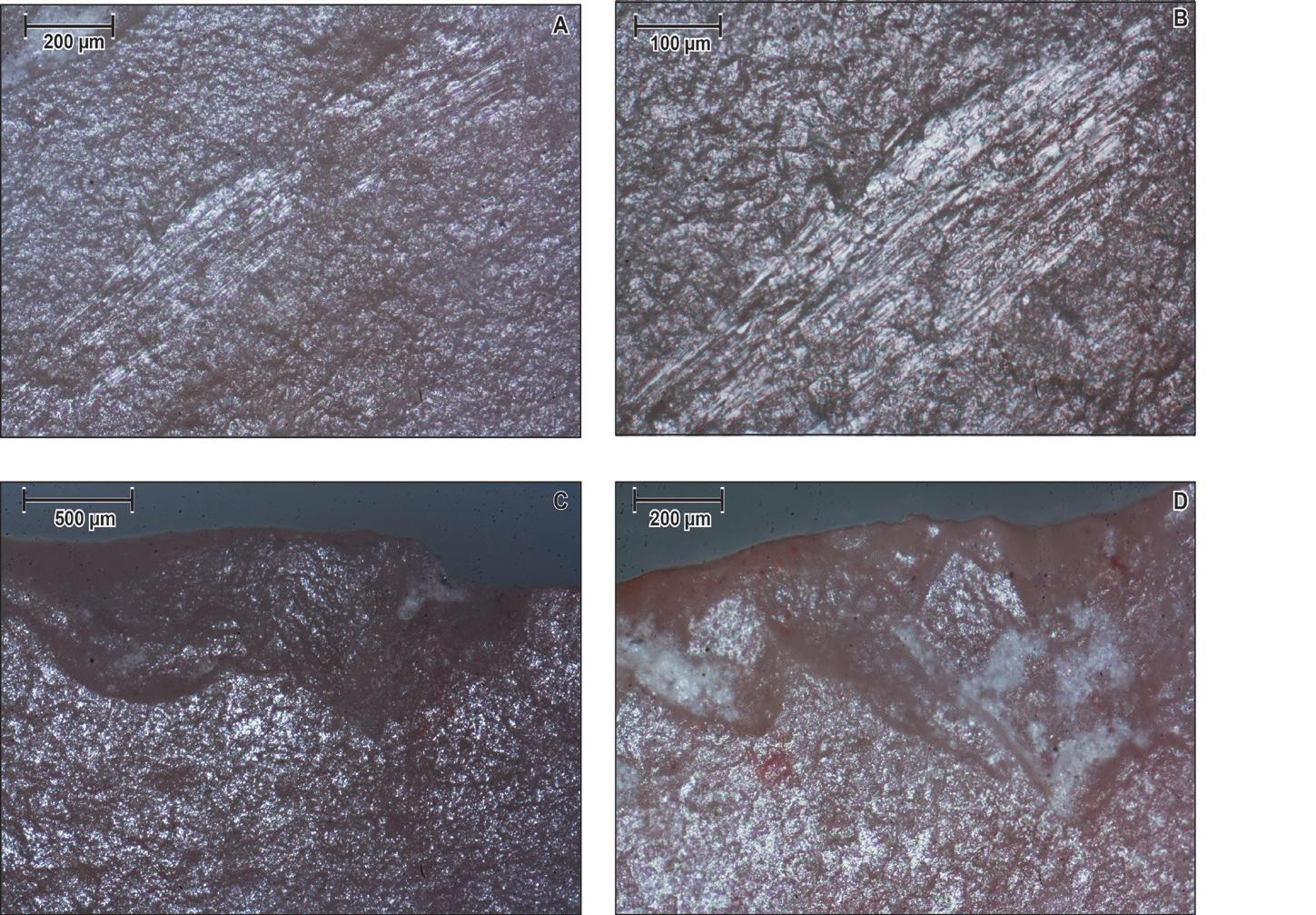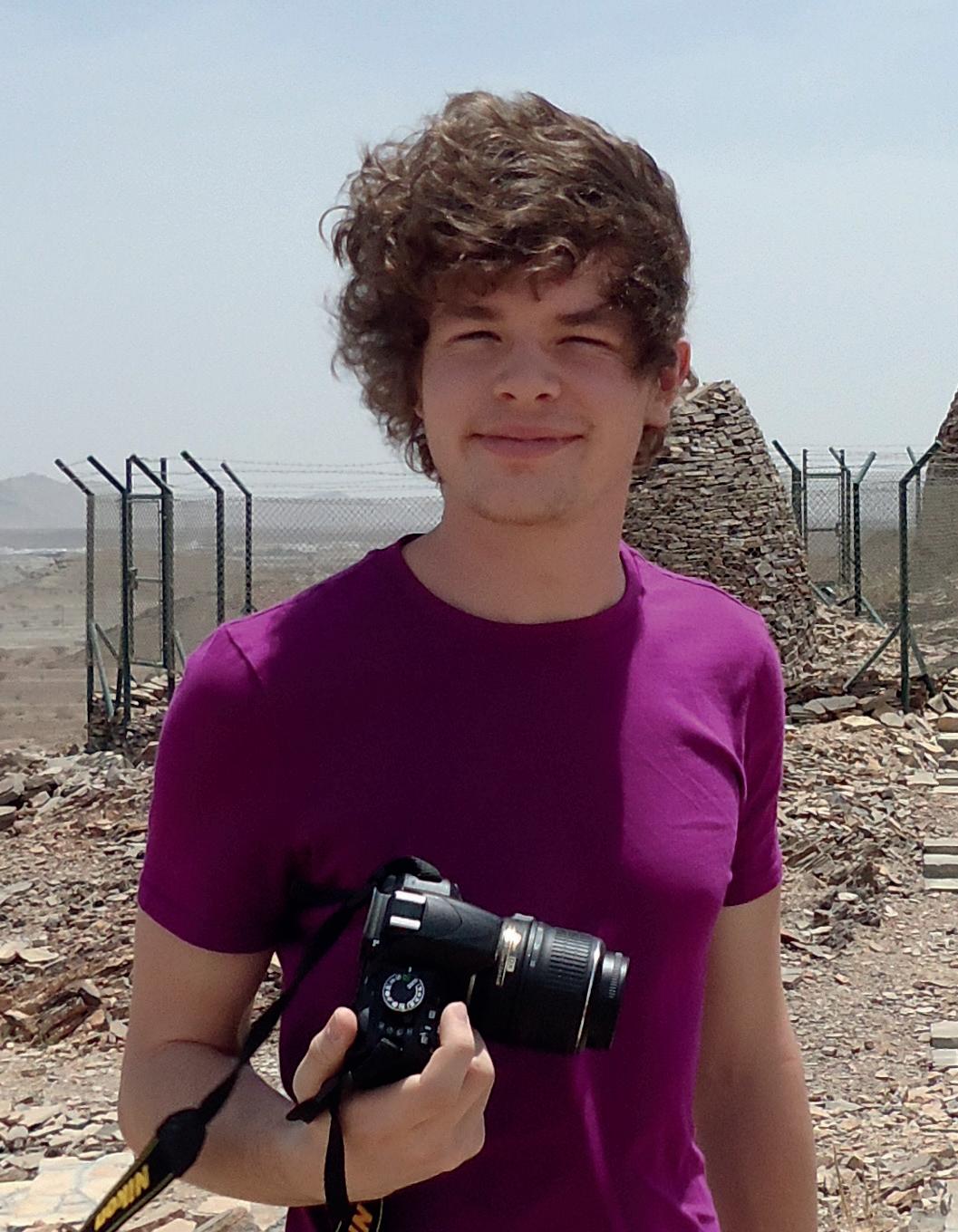
42 minute read
IASA NEWS
LETTER FROM THE EDITOR
This is my first IASA Bulletin as Editor, and it has been a pleasure to receive so many contributions to the publication from around the globe. We may be focused on the Arabian Peninsula, but we are able to keep in touch with our members, followers and supporters all around the world. I am extremely grateful to all of our contributors who have taken the time to submit their research or items of interest.
Advertisement
This first e-version of the Bulletin does not look very different, the main change is the increased use of hyperlinks, and the convenience of being able to zoom in on images, but as members will know we will be revamping our website shortly and will review the Bulletin design in tandem. Some sections of the Bulletin that don’t change between editions will move to the IASA website.
If you are wondering what has happened to the Book Review section, do not worry. Book reviews will appear in the Autumn issue of the Bulletin, thanks to the hard work of Review Editor Alexandra Hirst. As you know, this is the first time we have had a Spring and Autumn edition of the Bulletin, and we had so many excellent submissions for the Spring we decided to leave something exciting for the Autumn issue which will appear in September. IASA Monographs will also be featured in the next edition.
As Noel our Chair has pointed out, changes to the Bulletin have been driven by the response to last November’s member survey, but some are also consequences of the global pandemic. We are not able to report on as many 2020 conferences and exhibitions as usual, and some fieldwork activity has been suspended. This is a time of change and uncertainty for all, but I hope that you will find the activity reported on in this edition of the Bulletin to be as interesting and inspiring as I have.
Thank you, Carolyn Perry
TRUSTEE NEWS
Trustee biographies may be found on our website. Here we feature their latest news.
Dr Robert Bewley
I retired as the Director of the Endangered Archaeology in the Middle East and North Africa project in 2020, a project that began in 2015 and now has funding until 2024. More information on the project is available at http://eamena.arch. ox.ac.uk. In 2020, I was elected Chair of the Council for British Research in the Levant (CBRL). I intend to continue working in aerial survey for archaeology wherever I can but especially Jordan and Oman (http://www.apaame.org/ ) as the director of those projects. I trained as an archaeologist (at Manchester and Cambridge Universities) and was initially employed at English Heritage as an Inspector of Ancient Monuments in 1984. I moved to the Royal Commission on the Historical Monuments of England in the Air Photography Unit in 1987, and became the Head of Aerial Survey until 2003 (by then back in English Heritage). I was Head of Survey 2003-4, and then English Heritage’s Regional Director for the South-West 2004-2007 and became Director of Operations for the Heritage Lottery Fund (2007-2014). My research interests are in aerial archaeology, prehistory, landscape archaeology and the Middle East and North Africa.
Dr Noel Brehony
Our Chair Noel Brehony co-edited two books in 2020 and has another coming out this year. They are Building a New Yemen: Recovery, Transition and the International Community, co-edited with Amat Al Alim Alsoswa, published by I.B.Tauris; Global, Regional, and Local Dynamics in the Yemen Crisis co-edited with Stephen W Day, published by Palgrave Macmillan and Britain’s Departure from Aden and South Arabia: Without Glory but Without Disaster co-edited with Clive Jones, published by Gerlach Press.
Prof Clive Holes
Prof Holes reports that he is in the process of compiling an annotated glossary of the Arabic dialects of the Sultanate of Oman, based on data he recorded there while he was Director of the Language Centre at Sultan Qaboos University (1985-7). The data was recorded in the field at many locations all over northern and central Oman, as far south as the Jaddat al-Harasis. This will complement his earlier work on the northern Gulf, Dialect, Culture and Society in Eastern Arabia, published by Brill in three volumes between 2001 and 2016. The Omani glossary will be published in the online Open Access Semitic Languages and Cultures Series, Cambridge University Press.
Who is the person that sends you all those emails? Meet our Membership Secretary...
William Deadman
I was born in Ireland, to an English father and a Welsh mother. We moved back to the UK when I was a baby, and then to Oman when I was eight. My father taught and conducted research in the College of Agriculture in Sultan
Qaboos University, and we lived on campus. I hugely enjoyed growing up in such a beautiful country, with such friendly people, and going to a diverse international school in Muscat.
I moved back to the UK to study Archaeology at Durham University. By chance this was one of the few UK universities conducting archaeological research in eastern Arabia. For my BSc dissertation I carried out remote sensing and ground survey mapping Hafit tombs around Wadi ‘Andam in Sharqiyah. I continued my research into Early Bronze Age Oman at Durham as a postgraduate, examining the nature of Umm an-Nar society for my MA, and mapping the distribution of Hafit tombs across the Batinah for my PhD. I also joined the Rustaq-Batinah Archaeological Survey project, and greatly enjoyed carrying out multiperiod surveys with the RBAS team. I now work for Durham wing of the Endangered Archaeology in the Middle East and North Africa project, teaching local partners in Lebanon and Iraq how to use the EAMENA Arches site database, as well as GIS and map-making skills.
IASA LECTURES
The IASA holds at least three online events per academic year, in addition to the Annual Beatrice de Cardi Lecture, named in honour of our late President, usually held in the Summer following the AGM. If you are a likeminded organisation and would like to hold a joint event please contact us via bulletin@theiasa.com. Members with suggestions for events are also very welcome to forward them.
28 September 2020 'Arabian Renaissance', a new documentary film followed by a panel discussion (via Zoom) with filmmaker Patrick Mark of Mark Stewart Productions and archaeologists featured in the film.
Members enjoyed an exclusive showing of ‘Arabian Renaissance’, a new documentary made by Patrick Mark of Mark Stewart Productions. The film shows the work of Saudi and international teams who have collaborated on a range of projects across the Kingdom in recent years. Archaeology in the Kingdom of Saudi Arabia has indeed entered a golden period, and the beautiful film footage of the landscape, combined with a chance to see many of the sites and hear interviews from those involved makes for a very interesting and visually exciting hour of viewing. The documentary highlights the sheer range of discoveries arising from studies of the Peninsula’s climatic history to underwater excavations in the Red Sea, and the exploration of several lost cities. The filmmakers had travelled the length and breadth of the Kingdom in order to present this celebration of the renaissance of Saudi archaeology, sometimes joining teams mid-excavation. We were very lucky to have film-maker Patrick Mark with us for a panel discussion following the documentary, chaired by Derek Kennet and also including Michael Macdonald. The magic of Zoom meant that other archaeologists featured in the film could also join the discussion and answer some of the questions from the audience. Report by Carolyn Perry
28 September 2020 Dr Julian Jansen van Rensburg ‘Soqotra’s forgotten and endangered heritage‘ (co-hosted with the British-Yemeni Society and the MBI al Jaber Foundation).
The island of Soqotra has a rich and ancient history that speaks of millennia long interactions with people from throughout the ancient world. Yet, it remains better known for its unique flora and fauna than its rich cultural heritage. This situation has recently begun to change with a revival of interest by international and Soqotri individuals, whose work has begun to outline the complex and diverse cultural heritage of Soqotra, thanks to the Soqotra Cultural Heritage Project on which Julian worked. The project was funded by the DCMS and the British Council through the Cultural Protection Fund between 2017 and 2019 and run by the Centre for Middle Eastern Plants at the Royal Botanic Garden Edinburgh in collaboration with a number of partners. The project worked with Soqotris and consulted them about the outcomes they wished to see from the project, which included the capacity to document cultural heritage, to produce resources such as a usable database, and to develop conservation and tourism so that the benefits of the project could be shared with others.
International Association for the Study of Arabia (IASA) Following a brief overview of the work of previous surveys on the island, Julian showed some of the sites that had been revisited and the challenges around identification, and also a number of sites catalogued for the first time during the project. He also identified some of the threats facing the island’s cultural heritage, including looting and development. In order to aid protection of sites, a Soqotra Cultural Heritage Database was built using ARCHES, to enable the locals to be able to input new sites, protect and conserve their heritage and raise awareness at home and abroad.
Julian also highlighted the importance of Soqotra’s intangible cultural heritage. The Soqotri language is not officially classed as endangered, but under increasing pressure from outside influences there are fewer people able to speak it. One of the ways in which the language is preserved is through poetry, and two heritage festivals were held during the project, bringing together poets, singers, dancers and local theatre groups at which only Soqotri was spoken or sung. Soqotra is also renowned for its handicrafts, such as rugmaking, and pottery. Aloe harvesting is another traditional activity with a long record on the island. Finally, Julian noted a wide range of folk games played on the island that are enjoying something of a resurgence. These activities have now been mapped, and there is considerable overlap in areas of tangible and intangible heritage.
However, notwithstanding all these efforts to record and preserver Soqotra’s heritage, the island’s heritage is at threat from climate change, with buildings and sites in dire need of conservation and protection, increased development works and looting. It is hoped that sustainable tourism may play a part in raising awareness and preservation.
For more information on the project see the website https:// www.soqotraculturalheritage.org/ or follow on Twitter @ SoqotraHeritage. See Julian’s talk on our YouTube channel. Report by Carolyn Perry
12 November 2020 Diana Darke ‘Stealing from the Saracens: How Islamic Architecture Shaped Europe’
Diana Darke is well known to IASA members for her writings on Syria. She is an Arabist and scholar who has lived in the Middle East for over thirty years. This lecture was based on her recently published and well-received book and was beautifully illustrated by a series of marvellous slides.
The fire at Notre Dame de Paris of 13 April 2019 inspired her to take up her pen to write the book. However, she had been thinking of the theme of the book for some years. She has deployed her knowledge of Arabic, architecture and even mathematics to show that Notre Dame was “not quite as European as Europeans think”. Like many of Europe’s most iconic buildings it has been profoundly influenced by Islamic architectural innovations, some original and others adapted from the pre-Islamic period. In her view, the built evidence is there for all to see. No one owns architecture and everyone builds on what went before. The influence of Islam may be little understood today but was acknowledged 300 years ago, when there was a period of intense interest in Arabic studies: no less an architect than Christopher Wren commented that “The Gothic style should rightly be called the Saracen Style.”
Among the features brought to Europe from the Islamic world were pointed arches, ribbed vaults, spires, and rose windows and trefoil arches as well as an innovative technique for the building of domes. These emerged over time from a blending and embellishment in Islamic lands of techniques inherited from the Byzantines and Romans (visible today unless destroyed by conflict in the Dead cities in Idlib) and then taken to Europe following the earlier path that led from Antioch to the San Vitale mosaics in Ravenna. The work of Muslim master artists and architects can be seen at the Umayyad Mosque in Damascus, the Dome of the Rock in Jerusalem and Hagia Sophia in Istanbul.
There was much movement between Europe and the Middle East as pilgrims, abbots, monks, merchants and craftsmen were on the move and Islamic influences flowed through three principal routes. The most important was from the Levant. Crusaders, for example, found that the curved surfaces on fortresses offered better protection against missiles than the straight lines of European castles. Umayyad Spain had a profound influence. Advances in mathematics at the Abbasid court in Baghdad were brought to Cordoba and employed in building the dome and ribbed vaulting of the Mesquita. One of Diana Darke’s slides showed the marks in Arabic made by masons who had worked on the Mesquita. The third route was Amalfi, where local merchants inspired the import of the pointed arch they had observed at the Ibn Tulun mosque in Cairo. Brunelleschi’s dome of Florence’s cathedral seems to have been based on knowledge both of Islamic construction techniques and the writings of an 11th-century century scientist in Cairo. Much later examples were in the Gothic revival of the nineteenth century. Antoni Gaudi the architect for the Sagrada Familia in Barcelona openly acknowledged his debt to Islamic influences.
Diana Darke said her entire life could be viewed as an apprenticeship for writing the book” and thus giving the lecture. She brought her years of study and observation to give an entertaining, informative and memorable lecture. Those that missed it will want to read her book or go to You Tube where her lectures can be found. Report by Noel Brehony
30 November 2020 Panel Discussion on ‘Recent Archaeological Discoveries in Saudi Arabia’
Hosted with the King Faisal Centre for Research and Islamic Studies.
IASA Chair Noel Brehony introduced a panel discussion on archaeological discoveries made in Saudi Arabia over the last few years which are transforming our knowledge about some of the most ancient periods of human occupation in the Arabian peninsula. The panellists addressed the occupation history of Arabia, the regional connections between Arabia and the wider world, and the relations between people and climate. The panel comprised Dr. Jassir bin Suleiman AlHarbash, CEO of the Heritage Commission, KSA, and formerly General Supervisor of The National Program for Handicrafts and Saudi Crafts, Dr. Abdullah M. Alsharekh, Associate Professor, Department of Archaeology, King Saud University and Advisor at the Ministry of Tourism and Michael Petraglia, Professor of Human Evolution and Prehistory in the Max Planck Institute for the Science of Human History, Jena, Germany. Dr. Alsharekh is the main collaborator on a number of archaeological research projects in Saudi Arabia, including Palaeodeserts (MPI), Disperse and Surface (York), the Camel site (CNRS) and is head of the Thumamah Project (KSU). Professor Petraglia has led major, long-term interdisciplinary archaeological projects in Saudi Arabia involving collaboration with environmental scientists, palaeontologists, geographers, geologists, geneticists, and biological anthropologists, among others. The panel was moderated by Dr. Derek Kennet, University of Durham.
The panel discussion may be viewed on the KFCRIS YouTube channnel.
21 January 2021 Michael Macdonald ‘Tweets from an ancient desert’
Michael Macdonald, IASA Trustee and currently the director of several projects which record the many thousands of graffiti carved by ancient nomads in the deserts of what is now Saudi Arabia and Jordan, presented the first IASA lecture of 2021, ‘Tweets from an Ancient Desert.’
In his presentation, Michael made a very interesting comparison between the modern practice of tweeting and the graffiti of the nomads in the ancient Arabian deserts. These graffiti, like tweets, are not communications to a particular individual but are a spontaneous public expression of personal thoughts and opinions which can be read by anyone. Michael explained that, as nomadic life in the desert involved long periods of solitary idleness, graffiti was the perfect medium; the text could be as short or as long as the author wanted and, since they were carving for their own amusement, they could say whatever they liked and in whatever order their thoughts occurred to them. Michael also talked about the existence of trolls who vandalised other
people’s graffiti, often by subtly altering the letters to make it say something different.
Scores of thousands of graffiti by large numbers of individuals still exist in an area which could never have supported a very large population at any one time, thus suggesting that there must have been almost universal literacy among the nomads of the Syro Arabian deserts over a considerable period. The layout of the graffiti often seems chaotic: there are no spaces between words, no word dividers or vowels, and sometimes the text runs from right to left and left to right, or first in one direction and, on the next line, in the opposite direction. The internal structure of the graffiti, however, is almost always the same, usually starting with the author’s name and that of their father, continuing with a genealogy that is sometimes taken back to the mythical ancestor of the social group to which the author belonged, followed by a narrative and concluding with a prayer. The earliest firm date for this graffiti is the mid-6th century BC and the latest is eight centuries later and datable to AD 267. In between, there are many that mention the Nabataeans, the Jews, the Romans, the Persians and other peoples.
The tweeting nomads specifically discussed by Michael are those who carved the Safaitic graffiti, as these are particularly informative. He explained how they deal with personal relationships, loneliness and love, as well as describing the daily life of their authors, caring for their flocks of sheep and herds of goats and camels. There is a lot of sadness in this graffiti, for example, authors are sometimes grieving for people who are dead, who are captive, or who are sometimes just far away. These tweeting nomads were, however, remarkably well-informed about events in the world beyond the desert. In one inscription, for example, it seems likely that the mention of Caesar’s son refers to Germanicus, the adopted son of the emperor Tiberius, who came to Syria in AD18 and was received with great acclaim wherever he went. There are also several texts dated by Persian invasions or clashes between the Persians and the Romans.
Through these graffiti, vastly more is known about life in the desert between the last century BC and the 4th century AD than is known about life in the contemporary towns and villages. We have been bequeathed a picture of how nomadic society worked, of their social activities with each other and the outside world, of their inventions and their views of contemporary political events. But, as Michael said, above all, “these graffiti give us a direct line to the emotions of these nomads, their hopes and fears, their sadness and longing, their sense of humour, all expressed in very immediate terms – so that reading the tweets of these individuals, long dead, we empathise with them as we might with messages that just appear on our phones.”
The lecture may be viewed on The IASA YouTube channel. Report by Marylyn Whaymand
FORTHCOMING IASA LECTURES
1 April 2021 Lecture by Michael Quentin Morton ‘Masters of the Pearl: a history of Qatar’ 7.30 to 19.00 (GMT). Via Zoom The son of an exploration geologist, Michael Quentin Morton grew up in Qatar, Bahrain and Abu Dhabi in the 1950s and 1960s. After qualifying as a barrister, he spent over 30 years in a legal career before becoming a full-time author. ‘Masters of the Pearl’ is his ninth book about the Middle East.
The Annual Beatrice de Cardi Lecture 2021 Date and location to be confirmed. Professor Hugh Kennedy FRSE FRAS FBA, SOAS University of London 'Al-Baladhuri's Account of the Muslim Conquest of Arabia'
14 October 2021 Lecture by Professor Peter Magee, Director of Zayed National Museum and the Head of Archaeology with the Department of Culture and Tourism, Abu Dhabi ‘How Abu Dhabi's archaeology is reshaping the understanding of the Global Neolithic’ Further details to be announced.
THE SEMINAR FOR ARABIAN STUDIES
The Seminar for Arabian Studies, founded in 1968, is the only international forum that meets annually for the presentation of the latest academic research in the humanities on the Arabian Peninsula from the earliest times to the present day or, in the case of political and social history, to the end of the Ottoman Empire (1922). Papers read at the Seminar are published in the Proceedings of the Seminar for Arabian Studies in time for the Seminar of the following year. The Proceedings therefore contain new research on Arabia and reports of new discoveries in the Peninsula in a wide range of disciplines.
The 2020 Seminar for Arabian Studies was postponed due to the pandemic; however the 54th Seminar for Arabian Studies, organized by the IASA, will take place on-line over the weekends of 2 – 4 and 9 – 11 July 2021 with the Casa Arabe, Cordoba, Spain, as virtual host. Although the Seminar will not be physically held in Spain, cultural links that connect the Iberian and Arabian peninsulas will be explored in two special sessions, one on the intellectual links (language, law, theology and culture) between Jazirat al-‘Arab and Jazirat al-Andalus and the other on the comparison of cultural environmental adaptations in the Arabian and Iberian peninsulas. The 2019 (53rd) Seminar for Arabian Studies was held in Leiden. A brief report on the Seminar featured in the last Bulletin, but Knut Bretzke has written a report on the Special Session on the Stone Tools of Prehistoric Arabia, now published as a Supplement to PSAS 50 (see below)
On Friday 12th July, a one-day special session entitled “Stone Tools of Prehistoric Arabia” was held during the 53rd Seminar for Arabian Studies in Leiden. This session aimed at compiling an overview of spatio-temporal patterns in lithic typo-technology in Arabia. Sixteen papers were presented and attracted an audience beyond stone tool enthusiasts. Twelve of these contributions were later peerreviewed and published in the Supplement to volume 50 of the Proceedings of the Seminar for Arabian Studies.
In Arabia, stone tools are abundant in many areas and can be found on many deflated surfaces often in proximity to raw material outcrops, on wadi terraces, adjacent to prehistoric lake relics or within settlements. For a long time, however, stratified archaeological records were rare and hence developing chronological frameworks was a challenge. The discoveries made by international archaeological projects conducted across Arabia in recent years have made essential contributions to our field; the archaeological investigation of human origins in the Arabian Peninsula and a better understanding of the cultural diversification throughout prehistory can be named as examples here.
This special session brought together lithic experts working on Arabian pre- and proto-history to discuss geographic and chronological patterns in continuity and breaks in lithic technology from Arabia and provide insights from experimental, traceological, technological and typological research. It also provided a platform for scientific exchange between researchers working in different periods that, at times, face the same problems.
The data, patterns and interpretations presented in the special session are an attempt to clear a path through the mist that still shrouds the tools used by our ancestors and hopefully someday will answer some of these questions. Contributions provided overviews of the Lower Palaeolithic and Middle Palaeolithic occupations in central, northern and southeastern Arabia, the early Holocene record from southwestern Oman, the Neolithic occupations of the Gulf Islands, introduced new records from northern Oman, described Bronze Age lithic traditions in UAE and Oman, and a lithic assemblage from the Iron Age of southern Oman. The special session on Stone Tools of Prehistoric Arabia and the supplement to Volume 50 of the Proceedings of the Seminar for Arabian Studies add to the sources of data on human behaviour through time from the perspective of stone tools. Due to the evident taphonomic constraints that prevent the preservation of organic material, archaeologists are often faced with nothing but lithics, and even those are sometimes in pitiful states of preservation. Usually, temporal depths of surface assemblages were estimated by comparing the technologies and tool types with those from areas that have seen substantially more research. The research presented here demonstrates how lithicists are working toward the
establishment of a local frame of reference to provide data to answer their specific research objectives. We hope that further research into these subjects will follow.
Dr. Knut Bretzke
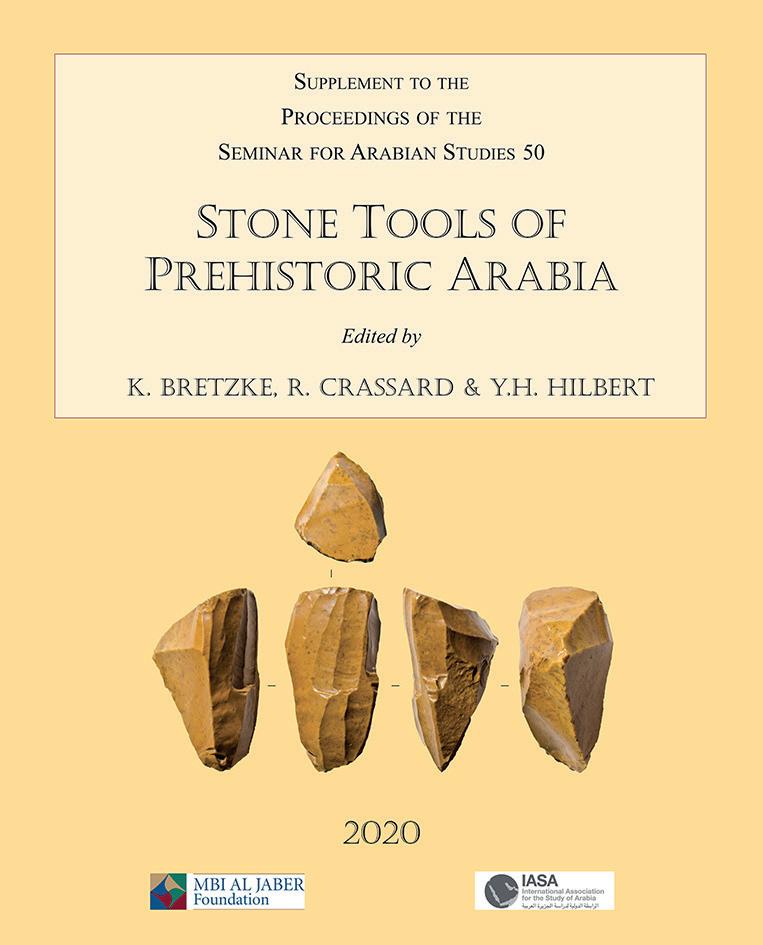
IASA PUBLICATIONS
PSAS Volume 50 2020 Papers from the fifty-third meeting of the Seminar for Arabian Studies held at the University of Leiden from Thursday 11th to Saturday 13th July 2019
Ed. Daniel Eddisford. ISBN 9781789696530
The Proceedings of the Seminar for Arabian Studies is a peer-reviewed series which each year publishes papers read at the Seminar the previous year. It is the prime source for the most recent research on the Arabian Peninsula within a wide range of disciplines and for the latest discoveries in the field. PSAS 50 was edited by Daniel Eddisford, assisted by an Editorial Board formed from members of the Steering and Editorial Committee of the Seminar, and other distinguished scholars. The most recent volume presents papers from the 2019 Seminar for Arabian Studies which was held at the Lipsius Building Leiden.
Stone Tools of Prehistoric Arabia: Papers from the Special Session of the Seminar for Arabian Studies held on 21 July 2019
Supplement to the Proceedings of the Seminar for Arabian Studies Volume 50 2020 edited by K. Bretzke, R. Crassard and Y.H. Hilbert.
Order from: Archaeopress www.archaeopress.com Email: info@archaeopress.com
IASA Monograph Series
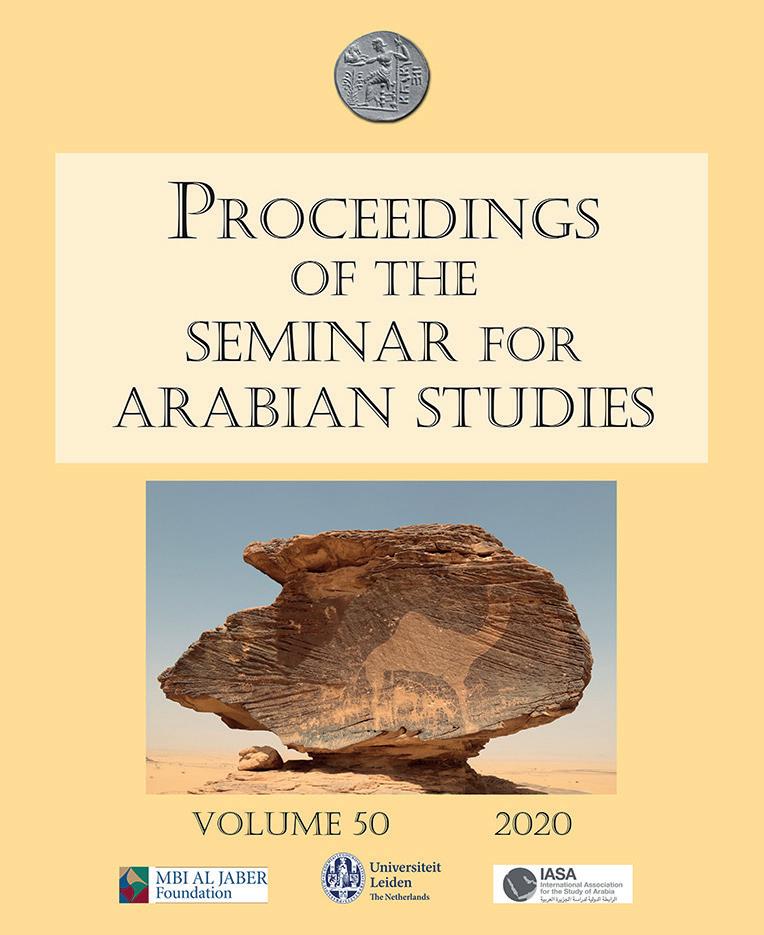
The Monograph Series will be featured in the Autumm edition of this Bulletin. For more information on the series, please see out website: https://www.theiasa.com/publications/monographs/
IASA RESEARCH GRANTS
In 2014 we received a very generous donation from our Patron Prof. Valeria Fiorani Piacentini. This donation enabled us to develop our research grant scheme and to increase the amount we award, enabling us to support more substantial and varied research projects. Later this year we will be launching an appeal in order to continue our grants programme at a significant level.
Our grants are intended to support research in any academic area covered by the IASA’s aims, which are to promote research relating to the Arabian Peninsula, in particular, its archaeology, art, culture, epigraphy, ethnography, geography, geology, history, languages, literature and natural history. They may be used to fund fieldwork, library or laboratorybased research or research support.
The main objective of the research must fit within the scope of the IASA’s aims, and applications must be linked to clear and achievable plans for immediate publication. The number of awards made each year will depend on the strength of applications.
There are two types of research grant: • Small Research Grants: up to £1,000 (for all categories of researchers)
• Main Research Grants: up to £4,000 (for postdoctoral research)
The deadline for applications is 15th May each year. Awards are announced by the middle of June. Applicants to the Main Research Grants should normally hold a doctorate at the time of application. Exceptions can be made for researchers with a proven track record of post-doctoral level research and publication. Applicants for Small Research Grants may be at any level of their career, though normally at least in the second year of a relevant university undergraduate degree.
The grants are available to researchers of any nationality. Individuals or groups can apply but the Principal Investigator of any project must make and be responsible for the application. If funding is being sought for a component part of a larger project, the sub-project should be free-standing with its own objectives. Generally, equipment costs should not comprise more than about 10% of the total budget. Higher proportions will be considered if the case is made in the application. Conference attendance will not normally be funded unless it can be shown that attendance will contribute in a significant way to the research and publication. Institutional overheads will not be covered. Salaries for short-term research staff are allowed but replacement teaching costs for academic staff will not normally be considered. For more details, and how to apply: www. theiasa.com/research/grants/
GRANTS AWARDED 2020
In 2020 the IASA awarded two research grants, one to Professor Adrian Parker of the Human Origins and Palaeoenvironments Research Group, Oxford Brookes Univeristy, and one to Dr Akshyeta Suryanarayan, Fyssen postdoctoral researcher, at CEPAM-UMR, CNRS, Université Nice Côte d’Azur.
Summaries of the projects funded are provided below. Reports on the results of the work will be included in future editions of the IASA Bulletin and also on the Research page of the IASA website: https://www.theiasa.com/research/
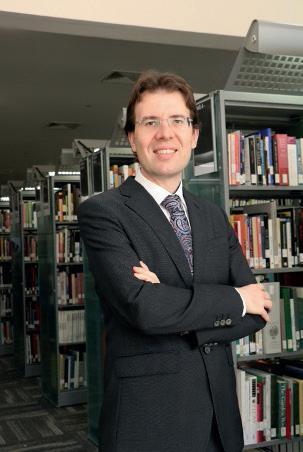
A study of late Quaternary coastal evolution and sea-level change at Jazirat Hulaylah, Ras alKhaimah, United Arab Emirates
Professor Adrian G. Parker, Human Origins and Palaeoenvironments Research Group, Oxford Brookes University
The highly productive marine environments that stretch along the southern margin of the Arabian Gulf have been the focus of human exploitation and settlement since the Neolithic to the present day. Despite this, the long-term evolution of the coastline in this area remains understudied in comparison to the landscapes of the desert interior. The proposed project will build on the ongoing work of the PI and Co-I at Umm al-Quwain and Jazirat al-Hamra and investigate coastal evolution at Jazirat Hulaylah, United Arab Emirates (UAE), one of the few remaining areas of natural coastline within the northern Emirates.
Organic networks across the ancient Persian Gulf
Dr Akshyeta Suryanarayan, CEPAM-UMR This project will re-examine exchange networks in the Persian Gulf from the Neolithic till the Iron Age by creating a database of sites from a comprehensive review of existing literature; using it to model knowledge networks, land and sea connectivity routes and the relationship between sites and material culture through spatial network analysis. It will also investigate the contents of local and imported ceramic and softstone vessels from selected sites in south-eastern Arabia, Bahrain and Oman using organic residue analysis. This unique approach will be the first study combining broader-scale network analysis with molecular- level analysis on artefacts in the region.
PAST GRANTS UPDATE
We caught up with Jörg Matthias Determann who received a research grant from the BFSA (now IASA) in 2009. Here he tells us a little about his experience working in the region since then.
Teaching and Researching Arabia in Arabia
Dr Jörg Matthias Determann
Determann in the library on Virginia Commonwealth University’s Qatar campus in 2019
Have you been to Doha or Riyadh recently? Unfortunately, travel restrictions imposed in response to the COVID-19 pandemic have made it hard for any scholar from outside the Gulf to visit. I especially feel for early-career researchers whose plans for fieldwork were suddenly interrupted in 2020. I consider myself all the more privileged to have been able to spend years living and working in the Arabian peninsula. In
2009, I was fortunate to receive a grant from what was then the Society for Arabian Studies for my doctoral research on historiography in Saudi Arabia. This funding enabled me to interview Saudi historians in person and access local libraries for my thesis at the School of Oriental and African Studies (SOAS), University of London. The degree of doctor of philosophy, in turn, qualified me to return to the Arabian peninsula as an assistant professor. In 2013, I began teaching at the Department of Liberal Arts & Sciences on the Qatar campus of Virginia Commonwealth University.
Being based in Arabia has been inspirational for further investigating the history of the region. I learn at least as much from my students as they from me. From my conversations with them, I gained knowledge of local dialects and countless insights into the Gulf’s society and culture. This also fed into the research I was able to publish: After my first book, Historiography in Saudi Arabia, came a volume on Researching Biology and Evolution in the Gulf States in 2015. In this study, I asked how and under what constraints academics were able to engage with Charles Darwin’s theory, one of the flashpoints in debates about science and religion. I found that despite much hostility toward ideas of human descent from other primates, scientists were able to discover adaptations of animals and plants to desert environments. My students readily confirmed to me public opposition to evolution. Yet, they also pointed out instances, in which their high school teachers had praised Darwin.
While I continue to reside in Qatar and retain a strong interest in the wider Arabian peninsula, I have also broadened my research horizons. My third book, published in 2018, was on Space Science and the Arab Word. My fourth, appearing two years later, was entitled Islam, Science Fiction and Extraterrestrial Life. I thus became interested in the lives and work of Arab and Muslim astronomers, astronauts, writers and visual artists. My protagonists included the Saudi prince Sultan bin Salman, who went to space in 1985, and the Emirati novelist Noura Al Noman, author of Ajwan. Other figures I studied comprise the Egyptian geologist Farouk El-Baz, who participated in the Apollo moon landings, and the Pakistani filmmaker Saeed Rizvi. My reasons for looking beyond the Arabian peninsula were in part pragmatic and in part related to my teaching. If I ever lost my position, I thought I could more easily find a new job if I presented myself as somebody working on the wider Middle East rather than just as a specialist on Saudi Arabia. Moreover, the curriculum at Virginia Commonwealth University demanded that I teach the history of other world regions too. In my first year, I was tasked with surveying European history for undergraduates and introducing them to methods of historical research, more generally.
Even when discussing Europe, however, my students and I kept the Gulf in the back of our minds. As I turned my eyes toward the stars research-wise, I kept my feet on the ground by following Doha’s Arabic and English newspapers on a daily basis. This allowed me to engage the students with comparative questions. Can the United Arab Emirates be rightly called a “Little Sparta,” as it has been nicknamed in the media? Or are the differences between the austere ancient city state and opulent Abu Dhabi too great? Is Alexander the Great a unique figure in human history? Or was the young king of Macedon similar to some contemporary princes in the Near East in his quest for power and wealth or his founding of cities? Does the category of absolute monarchy apply equally to the Habsburgs and the House of Saud? Can we see enlightened absolutism not just in the Holy Roman Emperor Joseph II, but also in reformminded rulers of Arabia, for example?
What also enabled me to relate history to current politics is the extensive freedoms I have enjoyed on Virginia Commonwealth University’s Qatar campus. To find materials for teaching and research, I have had largely unrestricted access to the internet and to the vast collections of VCU and the Qatar National Library. The latter includes the Qatar Digital Library, a rich repository of scanned archival records. Although none of the countries in the Gulf region are democratic, I have always felt safe to discuss their politics. Of course, sensitive topics do exist, but in my experience not many more than in other places. Some of my Sunni students once told me that they were uncomfortable presenting about the history of the Shia, as they worried about offending classmates belonging to this branch of Islam. In many European or North American lectures halls, the Sunni–Shia split would be probably less delicate. On the other hand, since the formation of the Boycott, Divestment and Sanctions (BDS) movement, the Israeli–Palestinian conflict has arguably become a more charged topic on many campuses in the United States or Britain than it is in Qatar.
A sheltered workplace at an academic institution does not mean an absence of fears. A new destructive war always seems a future possibility for somebody living in Qatar, as it is a present reality for the people of Yemen or Iraq. Like my expatriate students, I hold a residency permit that is renewable, but comes with an expiration date. Nevertheless, what I may lack in terms of long-term security gives me empathy and understanding for so many others around me. And is compassion not one of the greatest qualities of any teacher or researcher?
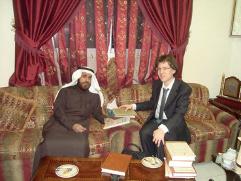
RESEARCH GRANT REPORTS
Two recent IASA grantees, Dr Gareth W. Preston and Dr Yamandú Hilbert, give summary reports of the results of their research. Full reports may be found on the IASA website at https://www.theiasa.com/research/
A chronological investigation of palaeoenvironmental change in Wadi Iddayyah, United Arab Emirates
Dr Gareth W. Preston and Ms Kira Raith, Human Origins and Palaeoenvironments Research Group, Department of Social Sciences, Oxford Brookes University, 69.07±4.93 ka. The deposition of these sands thereby falls within MIS 4 (~75 – 60 ka), a period characterised by overall hyper-arid conditions (Parton et al., 2015). The basal sands are overlain by ~4.00 m of (a) fluvially-deposited silts and planar-bedded sands interspersed with (b) minor carbonaterich sand deposits containing desiccation polygon mud curls. Four OSL ages were obtained from this unit: 38.40±1.91 ka, 36.60±1.68 ka, 35.80±2.23 ka and 30.49±1.71 ka. The sedimentological and geochemical data suggest that these deposits reflect repeated phases of channel flow which led to the reworking of aeolian sands by fluvial processes. The OSL ages from AQP fall much later in MIS 3 (~38.0 – 30.0 ka) than those reported from other fluvial records in the region (Parton et al., 2013).
This project presents new independent, age-constrained, empirical data of Arabian climate change and landscape response from sites identified along a previously unexplored ~30 km section of Wadi Iddayyah, UAE (Figure 1). The system is the main drainage feature within the Jebel Faya anticline, which has provided the earliest evidence of anatomically modern humans (Homo sapiens) identified in Arabia to date (~125 ka) (Armitage et al., 2011), The wadi was surveyed by the Co-I in March 2018 during which three key sites were identified: Aqabah Pylon (AQP), Wadi Iddayyah 1 (IDD1) and Wadi Iddayyah 2 (IDD2). A total of eleven Optically Stimulated Luminescence (OSL) samples were retrieved and dated. All ages are reported as preliminary results.
The basal unit (~0.40 m) at AQP (N25°2.569' E055°48.166') is comprised of aeolian sands which are OSL dated to The basal unit (~0.70 m) at IDD1 (N25°6.135' E 55°47.820') is comprised of aeolian sands which are OSL dated to 90.93±7.95 ka, thereby indicating deposition within MIS 5.2 (~105 – 85 ka). In contrast to the distinct humid phases recorded during MIS 5.5, 5.3 and 5.1, the lack of speleothem growth during MIS 5.2 (Burns et al., 1998) suggests a shift to more arid conditions. This is supported by evidence of aeolian activity elsewhere in Arabia (Rosenberg et al., 2011). The basal sands are overlain by a series of planar- and crossbedded sands, the uppermost of which is dated to 33.30±3.18 ka, which are suggested to reflect the reworking of aeolian sands by late MIS 3 fluvial activity.
IDD2 (N25°14.039' E55°40.343') is a series of fluvial terraces which run along the side of a small channel which has punctuated through the dunes away from the main wadi channel. At terrace A (0.45 m) a ~0.10 m unit of silts is
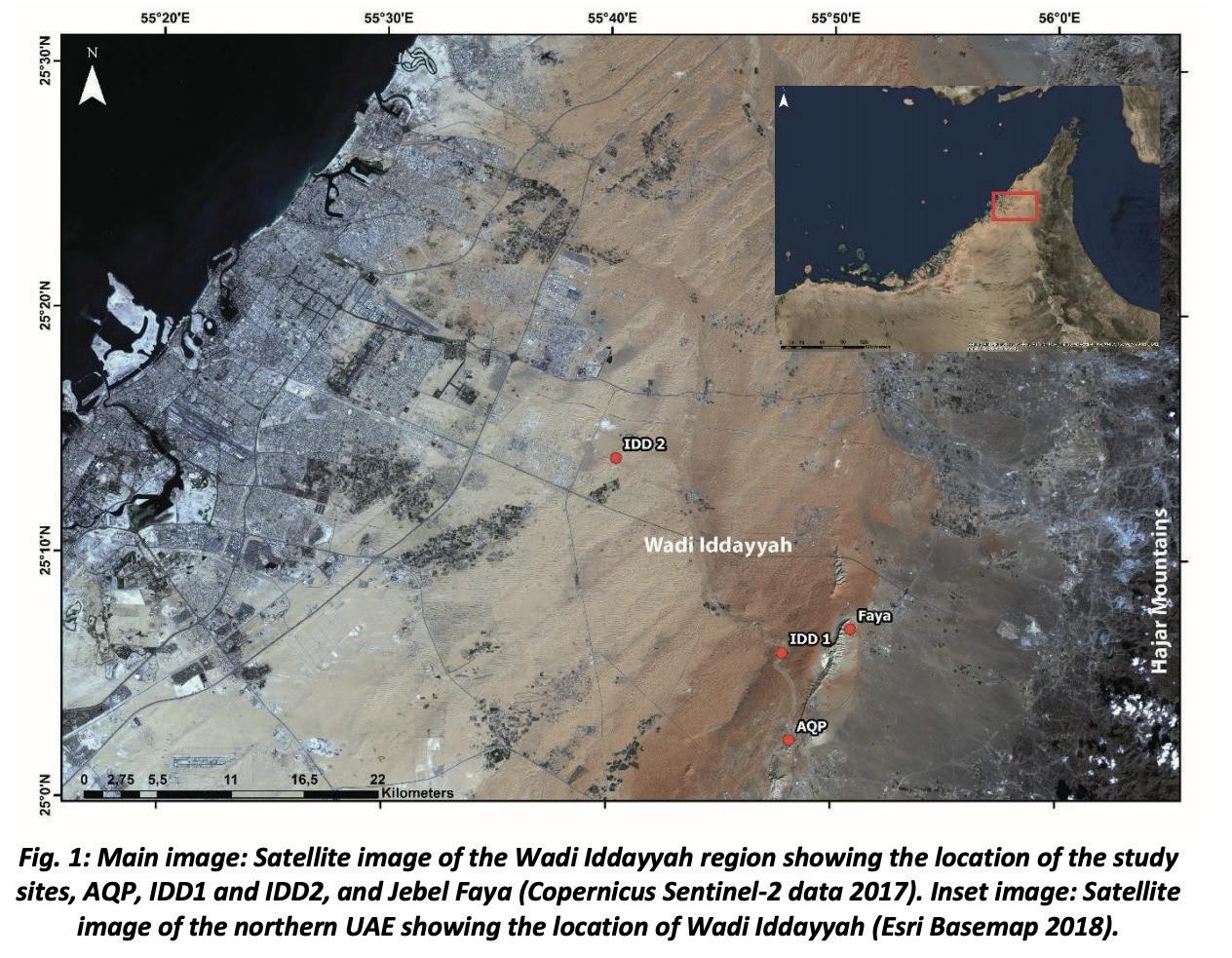
underlain by aeolian sands which are OSL dated to 15.42±0.91 ka. At terrace B (1.10 m) the basal unit comprises planar-bedded, very fine sands which are OSL dated to 17.46±1.05 ka. At terrace C two silt units are separated by aeolian sands OSL dated to 16.10±0.91 ka. The accumulation of these distinct silt deposits implies that there was sufficient rainfall to generate low energy channel flow or standing water during the otherwise hyper-arid conditions that are thought to have prevailed throughout MIS 2 (~30.0 – 11.50 ka) (Parker, 2009).
The deposition of aeolian sands at the base of IDD1 and AQP post-date the oldest known occupation phase (assemblage C) at Jebel Faya (Armitage et al., 2011). The next dated occupation phase at the site (assemblage A) yielded ages of 38.6±3.1 and 40.2±3.0 ka and is separated from assemblages C and B by undated sterile sediments, possibly reflecting a break in occupation between MIS 5.2 and MIS 3. The MIS 3 occupation layer is separated from a deposit containing early Holocene lithics (Fasad Points) by ~0.40 m of sterile sands which yielded ages of 38.6±3.2 and 34.1±2.8 ka (Armitage et al., 2011). These sterile sands are therefore broadly contemporaneous with the deposition of fluvial sediments at AQP. The implications of these findings are the focus of the Co-Is PhD research. A detailed report of the above findings is available on the IASA website.
Acknowledgments The OSL dating and laboratory analyses were kindly supported by the IASA. We thank the Department of Culture and Information of the Emirate of Sharjah and the Directorate of Antiquities, for permission to work in the region, and Knut Bretzke for his support during the fieldwork. We are grateful to Frank Preusser of the Sedimentary Geology and Quaternary Research group at the University of Freiburg and his team, including Daniela Mueller, Johannes Miocic and Alexander Fuelling, for their advice in the field and during the OSL dating work. We are grateful to Adrian Parker and Ash Parton for their constructive comments throughout the course of this project.
References Armitage, S. J., Jasim, S. A., Marks, A. E., Parker, A. G., Usik, V. I., Uerpmann, H. P. (2011) The southern route "out of Africa": evidence for an early expansion of modern humans into Arabia. Science 331, 453 – 456.
Burns, S., Matter, A., Frank, N., Mangini, A. (1998) Speleothem-based paleoclimate record from northern Oman. Geology 26 (6), 499 – 502.
Parker, A.G. (2009) Pleistocene climate change in Arabia: Developing a framework for hominin dispersal over the last 350 ka. In: Petraglia, M.D., and Rose, J. (Eds.), The evolution of human populations in Arabia: Paleoenvironments, prehistory and genetics. Springer, Netherlands, 39 – 49. Parton, A., Farrant, A.R., Leng, M.J., Schwenninger, J.-L., Rose, J.I., Uerpmann, H.-P., Parker, A.G. (2013) An early MIS 3 pluvial phase in Southeast Arabia: Climatic and archaeological implications. Quaternary International 300, 62 – 74.
Parton, A., Farrant, A.R., Leng, M.J., Telfer, M.W., Groucutt, H.S., Petraglia, M.D., Parker, A.G. (2015) Alluvial fan records from southeast Arabia reveal multiple windows for human dispersal, Geology 43 (4), 295 – 298.
Rosenberg, T.M., Preusser, F., Fleitmann D., Schwalb, A., Penkman., K., Schmid, T.W., Al-Shanti, M.A., Kadi, K., Matter, A. (2011) Humid periods in southern Arabia: Windows of opportunity for modern human dispersal. Geology 39 (12), 1115 – 1118.
Traceological analysis of Paleolithic backed points from Dhofar: insights into South Arabian projectile technology
Yamandú H. Hilbert1, Ignacio Clemente-Conte2, Najat alFudhaili3, Matthias López Correa3 , 4 1) Institut für Ur- und Frühgeschichte, Friedrich-AlexanderUniversität Erlangen-Nürnberg, Kochstr 4/18, 91054 Erlangen, Germany 2) Departamento de Arqueología y Antropología, Institución Milá y Fontanals, CSIC, Egipcía-ques 15, 08001 Barcelona, Spain 3) GeoZentrum Nordbayern, Universität Erlangen-Nürnberg, Loewenichstr. 28, D-91054 Erlangen, Germany 4) Consiglio Nazionale delle Ricerche, Istituto di Scienze Marine, via Gobetti 101, I-40129 Bologna, Italy
Projectile technology refers to launched weapons propelled by physical strength, that may have its range and speed augmented by mechanical force using specifically developed launching systems (i.a. spear thrower, bow, cross-bow, etc), with the intent to kill or wound a target. The significance of this technology to the evolution of our species, the chrono/ cultural variability, geographical distribution as well as the impact it made and still makes on archaeological interpretations are the subjects of many scientific articles and books (see Knecht, 1997 and ref. therein). The oldest uses of projectiles in South Arabia remain largely understudied.
Here, we focus on the stone insets attached to the wooden shaft that serves as the projectile. One of the reasons for focusing on these insets is their durability in comparison with most archaeological organic remains. They show great morphological variability throughout the Stone Age (Paleolithic) and reach their absolute peak in display of skill and craftsmanship during the Neolithic. This variability is a result of how points were hafted, shot, whether made from organic and inorganic material, as well as from a vast array of social factors.
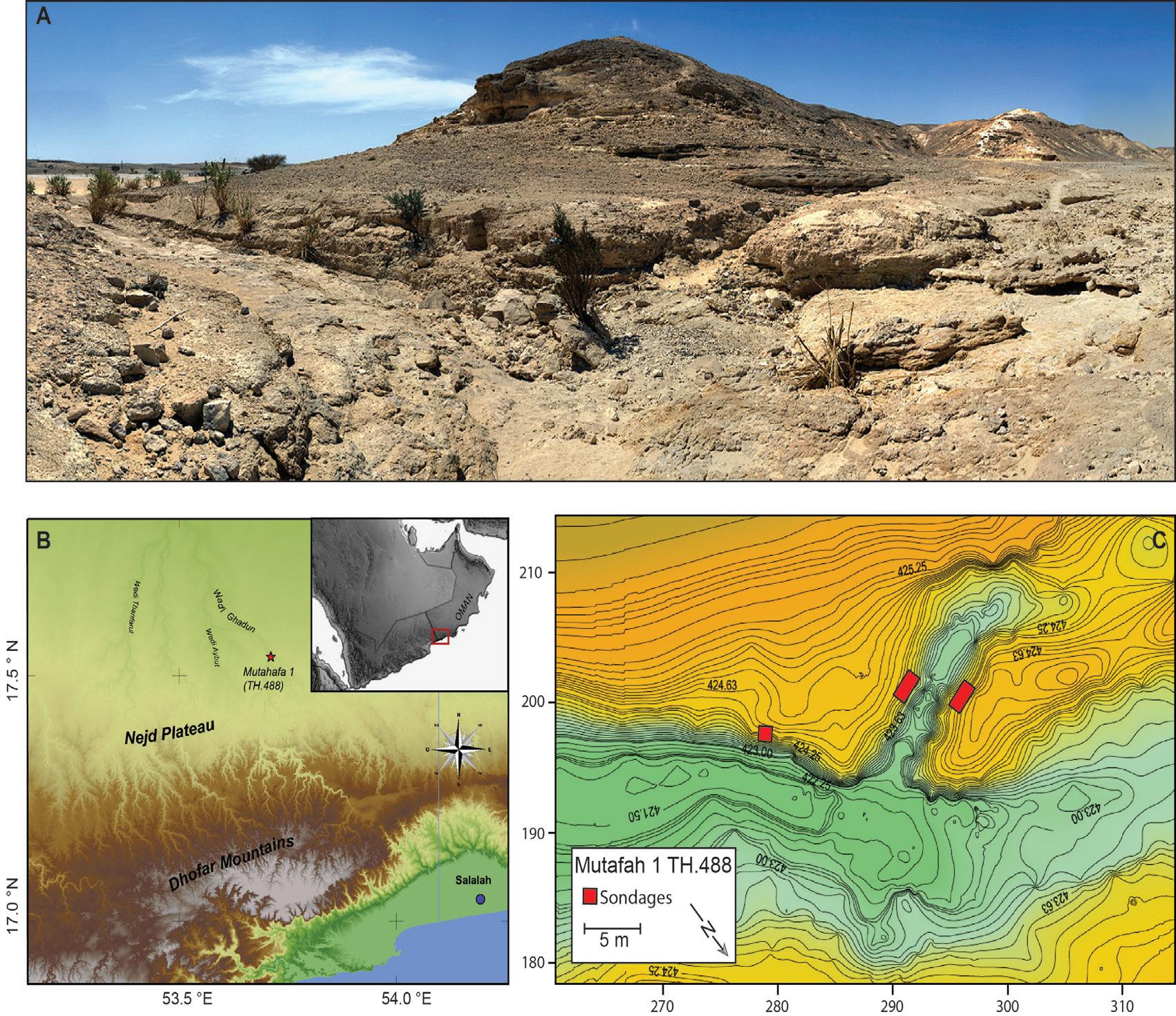
Figure 1: View of the Upper Paleolithic Mutafah 1 site (A) in Southern Oman. (B) Location map and (C) detailed topography and sondage positions at Mutafah 1 excavated in 2013 (see Rose et al., 2019).
Thanks to the generous support of the International Foundation for the Study of Arabia a traceological study (sensu Semenov, 1964) of the backed points from the Upper Palaeolithic site of Mutafah 1 dated to approx.30,000 years ago was conducted (Figure 1). The small sample of lithics was excavated in 2013 and published in 2019 (Rose et al., 2019). The backed points and the OSL chronology of the site indicate the presence of a human population in South Arabia during a period of aridity (Hilbert et al., 2018). In total, 16 artefacts have been exported from the Sultanate thanks to
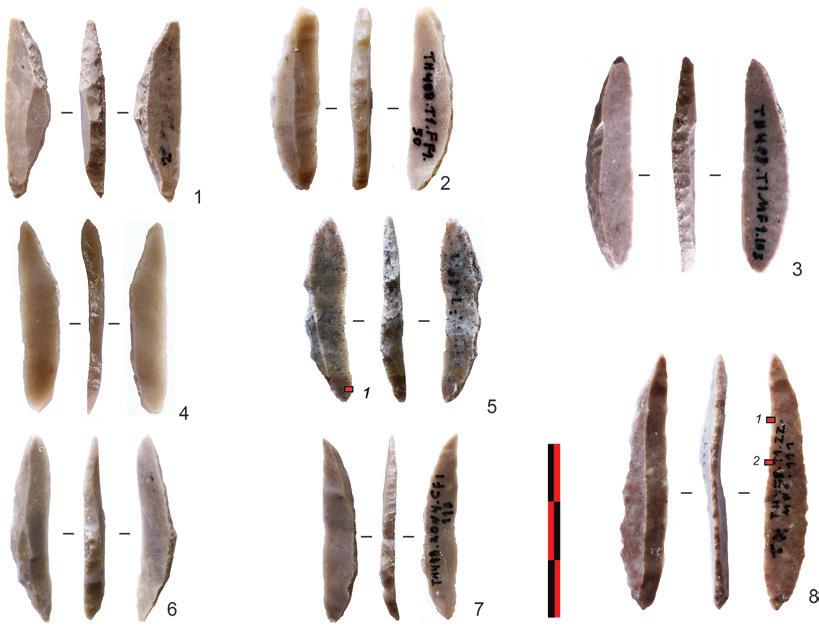
Figure 2: Characteristic backed points from Mutafah 1. The red marks on artefact #5 shows the position of the identified linear impact traces seen in fig 4 A and B. Marks on artefact #8 show where the micrographs B and D seen in figure 4 have been taken.
permits issued by the Ministry of Heritage and Culture of Oman. The analyses were conducted at the microscopy laboratories of the CSIC-IMF in Barcelona and at the University of Erlangen. By scanning the edges and surfaces of the tools under different magnifications (from x1 to x800), macro- and microscopic traces including scars, micro-polished spots, scratches, striations, residues, microscopic impact traces, are identified and compared to an experimental reference collection.
The majority of the pieces (Figure 2, left) show continuous abrupt retouch from tip to bottom creating a deliberately curved shaped back. Both the distal and proximal terminations of the artefacts show deliberate traces of shaping by fine direct percussion, forming a bi-pointed arched backed lithic inset. These arched backed bladelets share specific technological and morphological features making it germane to propose comparable operational sequences for the manufacture of these tools.
Microscopic residues were found attached to the tip of specimen #50 (Figure 3, below). The residue is characterized by a smooth and highly reflective surface, that shows a specific mud-cracked pattern. SEM-EDS analysis of the residues is currently underway.
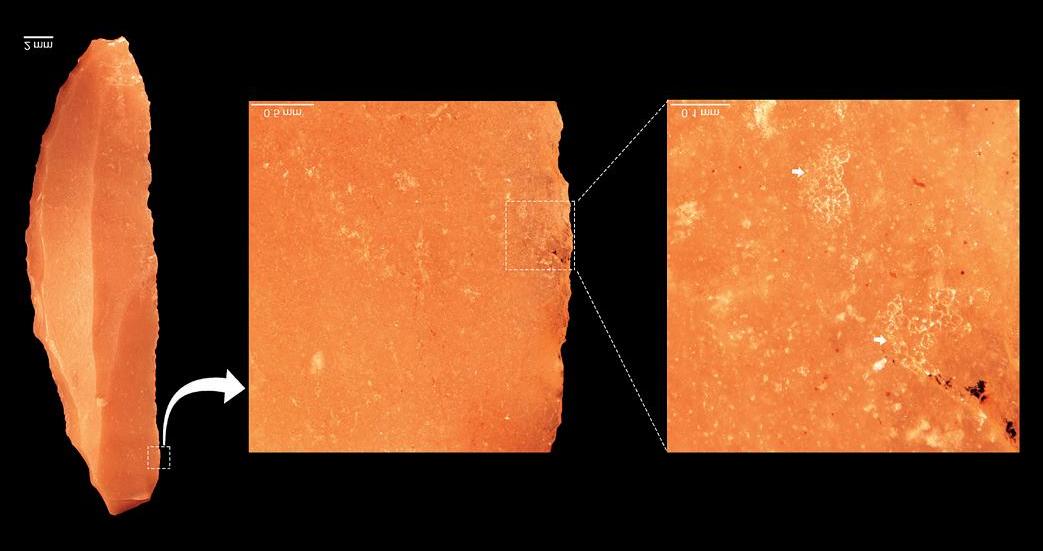
were manufactured with the same specific technical system may present different functional applications.
References Hilbert, Y.H., Geiling, J.M., Rose, J.I., 2018. Terminal Pleistocene archaeology and archaeogenetics in South Arabia : Evidence from an ice age refugium, in: Purdue, L., Charbonnier, J., Khalidi, L. (Eds.), Vivre En Milieu Aride de La Préhistoire à Aujourd’hui. Presented at the XXXVIIIe rencontres internationales d’archéologie et d’histoire d’Antibes, Éditions APDCA, Antibes, pp. 33–49.
Knecht, H., 1997. The History and Development of Projectile Technology Research, in: Knecht, H. (Ed.), Projectile Technology, Interdisciplinary Contributions to Archaeology. Springer US, Boston, MA, pp. 3–35.
Moss, E., 1987. Polish G and the question of hafting, in: La Main et l’outil: Manches et Emmanchements Préhistoriques: Table Ronde CNRS Tenue à Lyon Du 26 Au 29 Novembre 1984. G.S. Maison de l’Orient, Lyon, pp. 97–102.
Figure 3: Residue on a backed point from Mutafah 1. Note the polygonal cracked pattern of the residue's surface.
portion of specimen #104 (Figure 4) points at its use as a projectile and indicates it has been shot; further three specimens show rounding and micro-polish along their backed portion. Such traces are referred to as “G” polish, or hafting wear (Moss, 1987), and indicate that the artefacts were mounted transversally to the wooden arrow (or dart), thus making use of the proximal point to serve as a barb. Spots of undulating, moderately developed micro-polish and associated negative edge-rounding caused by abrasion was observed on specimen #111, localized along the cutting edge of the tool which may indicate an alternative use of the bipointed tools in the processing of a soft and abrasive organic material, possibly the cutting of hides or the preparation of food.
The traceological results of the Mutafah 1 arched backed points show these artefacts to be used in at least two different activities, hafted as projectile points and likely used in hunting as well as in transformative/productive activities, showing them to be part of a mobile toolkit. This versatility in use demonstrates how stone tools that look the same and Moss, E.H., 1983. The functional analysis of flint implements: Pincevent and Pont d’Ambon: two case studies from the French final palaeolithic, BAR International Series. Archaeopress, Oxford.
Rose, J.I., Hilbert, Y.H., Usik, V.I., Marks, A.E., Jaboob, M.M.A., Černỳ, V., Crassard, R., Preusser, F., 2019. 30,000-Year-Old Geometric Microliths Reveal Glacial Refugium in Dhofar, Southern Oman. Journal of Paleolithic Archaeology 2, 338–357.
Semenov, S.A., 1964. Prehistoric Technology: an Experimental Study of the Oldest Tools and Artifacts from Traces of Manufacture and Wear. Barnes and Noble, New York
